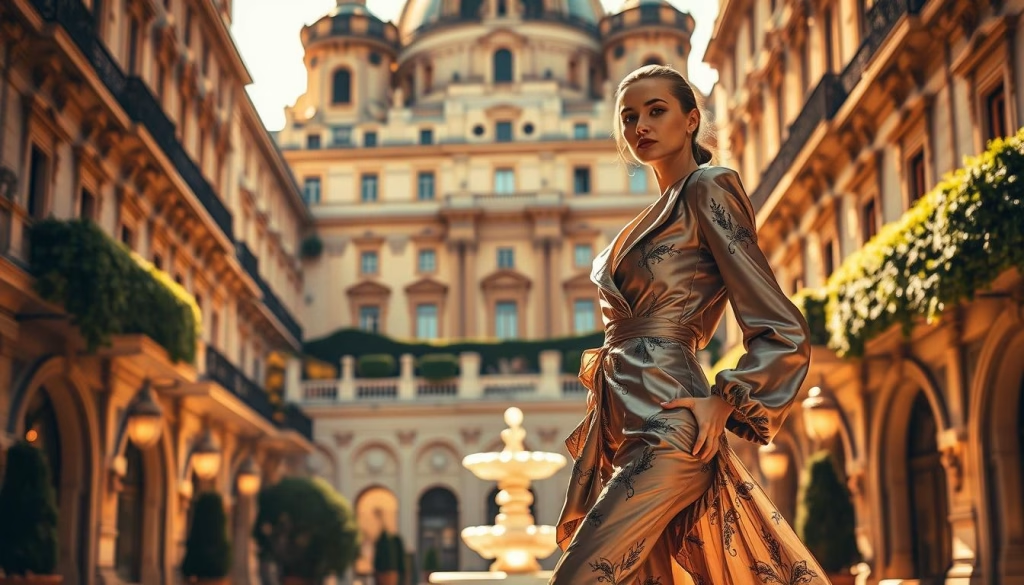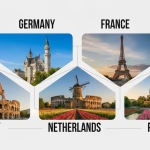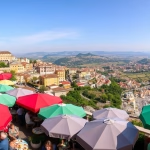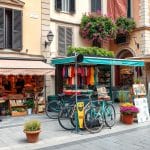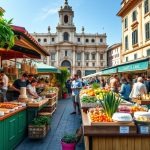We invite you to a concise tour of sartorial culture that blends craft, art and everyday elegance.
- Why we say Italy is synonymous with fashion and design
- Renaissance roots: textiles, art, and the birth of Italian style
- The bridge between Haute Couture and ready-to-wear
- Institutions and industry: the rise of a sartorial superpower
- The 1980s Made in Italy boom that shaped global fashion
- Craftsmanship and materials: leather, silk, and beyond
- Iconic signatures and design codes we all recognise
- Italian designers who defined an era
- Milan Fashion Week and the city that dresses the world
- From workshop to world stage: brands like Gucci and Prada
- The business of style: numbers behind the Italian fashion industry
- Sprezzatura and the Italian way of dressing
- Italy’s fashion today: sustainability, innovation, and craft
- Where we see Italian fashion in the UK right now
Sumptuous cashmere, perfectly tailored suits and supple leather loafers form a shorthand for italian fashion today. Milan acts as the city that dresses the world, where ateliers and new labels meet in lively showrooms.
We will chart how heritage techniques and modern minds shape styles across streets and runways. Quality and craftsmanship remain non-negotiable, from Renaissance textiles to small workshops and luxury houses.
Expect practical insight: we explain how to read Italian style on the high street and in premium retail, and why this country’s blend of creativity and commerce still sets global trends.
Why we say Italy is synonymous with fashion and design
Local craft, museum-worthy art and trade infrastructure together turned regional techniques into global trends.
Our aim is straightforward: to give a concise, authoritative guide that explains why italian fashion holds such sway. We map the key years and milestones, and name the italian designers and brands that matter.
Below we explore three linked ideas: roots in history and art, the rise of household brands, and how ateliers shape street styles.
User intent and what we’ll explore
- How historical textiles and art informed modern styles.
- Which brands and designers rose to prominence during crucial years.
- Why milan fashion infrastructure accelerates influence.
From atelier to street: how style permeates life
Workshops and small ateliers supply finishing details that signal taste without loud logos. Cut, drape and material choice make craftsmanship visible in everyday life.
We will use clear criteria—heritage, innovation and consistent voice—to assess labels. Expect examples that show inspiration becoming recognisable products and looks.
Renaissance roots: textiles, art, and the birth of Italian style
Wool, silk and velvet drove an economic and cultural boom across Venetian, Florentine, Roman and Milanese workshops. We trace how these materials shaped silhouettes, trade and social rituals in a pivotal century.
Wool, silk, and velvet in Venice, Florence, Rome, and Milan
Textiles were central to production and local pride. Guilds kept standards high and ensured skilled work stayed in city‑state hands.
Wool gave garments structure. Velvet added depth. Silk provided sheen and movement, prized for court display and ceremony.
- Venice and Florence: masters of silk weaving and brocade.
- Milan and Rome: centres for sturdy wools and trimmed velvets.
- Workshops: refined techniques that set European taste.
The Medici influence and portraits that showcased fashion
Medici patronage turned dressmakers into early designers. Court commissions meant new cuts and lavish fabrics reached public view.
Portraits in the Uffizi act as visual records from the 15th century. They reveal trims, embroideries and materials that signalled rank and creative ambition.
Our conclusion: the Renaissance textile economy created a model of specialisation and collaboration. That heritage underpins later italian fashion, where craft, art and production continue to inform contemporary designs.
The bridge between Haute Couture and ready-to-wear
A decisive post‑war moment reshaped how high style could reach everyday wardrobes.
In 1951 Gian Battista Giorgini staged shows at Palazzo Pitti aimed at American buyers. He presented clothes in multiple sizes, making luxury garments practical and ready for sale.
This pivot mattered: it translated haute couture principles into wearable pieces while keeping refinement intact. Producers, ateliers and merchants began to work together to deliver consistent quality at scale.
- Giorgini’s curation linked designers and small makers to export markets.
- Local supply chains allowed faster production than traditional couture houses.
- Clean lines, superior fit and durable fabrics defined these early ready‑to‑wear ranges.
- Department stores soon formed lasting trade relationships that expanded distribution.
That season created a template: marry artistry to industrial production and you build an industry. We see this moment as the inflection point that set italian fashion on a sustainable path to global growth.
Institutions and industry: the rise of a sartorial superpower
Founding bodies and new machinery let small ateliers scale their craft without losing identity. In 1958 the Camera Nazionale della Moda created a formal system for calendars, standards and promotion. This gave producers a credible voice on the world stage.
1958 Camera Nazionale della Moda and the system behind style
The Chamber organised shows and lobbied for export support. Buyers began to trust Italian collections for consistency and timing.
Industrial production in the 1950s-60s and international momentum
Post‑war investment in machinery and textiles let brands move from single samples to series production. Small workshops became reliable suppliers for larger houses.
- Supply ecosystem: pattern‑makers, trimters and finishers formed regional networks.
- Production scaling: factories kept artisanal detail while increasing output.
- Brand impact: labels could plan assortments, replenish bestsellers and meet export schedules.
We trace a direct line from institutional support to international momentum. The combined system—organisations, mills and skilled workforces—turned heritage craft into a modern industry that still underpins italian fashion today.
The 1980s Made in Italy boom that shaped global fashion
In the 1980s, sharp tailoring and strong branding converted artisanal skill into a worldwide market force.
We chart how ateliers became household names by pairing clear visual signatures with reliable production. Designers such as Giorgio Armani, Miuccia Prada and Domenico Dolce & Stefano Gabbana led this shift, while Valentino, Gucci, Fendi, Ferragamo, Versace, Zegna and Missoni built multi‑billion luxury houses that reached new markets.
The decade rested on years of investment in mills and logistics. Trusted textiles and materials gave clothes a recognisable touch and drape. That supply base let brands scale without losing finish or fit.
- Production: small studios adopted series production while preserving artisanal detail.
- Visibility: milan fashion week amplified collections to buyers across the world.
- Market: strong storytelling fused heritage with modernity, creating loyalty that lasts.
We conclude that the 1980s codified a playbook—distinctive designs plus dependable production—that still drives the brand advantage and sets many contemporary trends.
Craftsmanship and materials: leather, silk, and beyond
Hand skill and material choice shape every step from sketch to finished piece. We focus on how bench work and precise machine craft produce consistent, luxury-grade results that define italian fashion.
We detail key materials—supple leather, fine silk and advanced fabrics—and how selection affects drape, durability and the final designs customers notice.
- Heritage techniques: hand‑cutting, edge painting and artisanal weaving meet calibrated production lines to keep finish exact.
- Material standards: textiles sourcing, colourfast finishing and component choice—zips, linings, interlinings—raise the product’s feel and function.
- Leather and silk: leatherwork sets global benchmarks from loafer construction to saddle‑stitch bags; silk performs in tailoring and eveningwear, often blended for crease recovery.
- Quality control: thorough inspections at each stage secure the Made in Italy promise and extend product life.
- Skills pipeline: craft schools and apprenticeships keep heritage techniques alive for future collections.
Conclusion: superior materials plus disciplined production give italian fashion its edge. Craftsmanship, taught and practiced, turns good textiles into great clothes.
Iconic signatures and design codes we all recognise
A clear visual language—colour, weave and hardware—lets us read a label before we see its name. These cues work like shorthand: they signal history, technique and intent.
Valentino red carries theatrical weight. It nods to haute couture while fitting modern silhouettes. The shade reads as drama and craft in equal measure.
Valentino red and Armani’s greige
Armani’s greige offers the opposite lesson: restraint. The muted tone shapes tailoring and soft suiting, proving that colour can define cut as much as cloth.
Gucci’s horsebit and Bottega Veneta’s intrecciato
The Gucci horsebit links equestrian roots to wearable luxury. It translates across shoes, bags and belts without needing an obvious logo.
Bottega Veneta’s intrecciato makes craftsmanship visible. Woven leather acts as both structure and ornament, signalling quality at a glance.
- We decode how colour, hardware and texture become brand codes.
- We show how couture techniques filter into ready-to-wear through finish and proportion.
- We explain how these signatures help consumers spot authenticity in the market.
Across labels, these visual markers keep italian fashion coherent. From giorgio armani’s relaxed cuts to bold couture moments, such codes let luxury brands evolve while staying recognisable.
Italian designers who defined an era
We trace a generation that shaped both the look and the business of modern style. These figures turned craft into recognisable codes and built houses that last.
Giorgio Armani, Miuccia Prada, Dolce & Gabbana
Giorgio Armani rewrote tailoring, favouring fluidity over stiffness and changing menswear and womenswear alike.
Miuccia Prada brought an intellectual edge, mixing utility and subversion to make everyday pieces feel new.
Dolce & Gabbana channel Sicilian drama — baroque prints and romantic cuts that span categories and seasons.
Valentino, Gucci, Fendi, Ferragamo, Versace, Zegna, Missoni
Valentino kept couture glamour in ready pieces. Guccio Gucci built a leather legacy that became cultural capital.
Fendi and Ferragamo advanced technical craft; Versace favoured bold print and cut. Zegna tied textiles to tailoring while Missoni made knit pattern a signature.
- We profile how these designers balanced continuity with experiment.
- We show how brands turned craft into business models for luxury brands.
- We conclude: know a designer’s core code and you can better read future designs and the global fashion they shape.
Milan Fashion Week and the city that dresses the world
The city’s weeks of shows act as both a creative forum and an industry marketplace. We watch how Milan Fashion Week anchors the italian fashion calendar and signals the season’s trends to buyers and press.
Concentration matters. The city hosts showrooms, suppliers and many leading brands, so appointments turn into orders quickly. Trade infrastructure and media coverage help collections travel from runway to retail.
We note practical mechanisms that make this work:
- Buyer appointments: focused slots that shape in‑season stock and adjustments.
- Collaboration: styling teams, production previews and capsule reveals align supply and demand.
- Market reach: international editors and buyers amplify coverage across the world.
Decades of investment in education, manufacturing and logistics underpin the city’s standing. Milan complements Paris, London and New York by turning creativity into clear commercial outcomes, keeping italian fashion central to the global fashion industry each season.
From workshop to world stage: brands like Gucci and Prada
Small family ateliers transformed careful stitching and trims into recognisable markers of luxury. We trace how founders turned bench skills into global operations and clear brand codes.
Luxury brands, market influence, and enduring trends
We show how brands like gucci and like gucci prada grew by anchoring reputation in superior materials and strict quality control. Leather mastery and precise finishing gave products a tangible advantage in retail.
Designers set a visual language that carries across bags, shoes and ready ranges. A hardware motif or a weave makes a house recognisable without loud logos.
- Supply partnerships: regional workshops kept standards high while meeting export demand.
- Market tactics: flagship stores, digital storytelling and collaborations kept heritage relevant.
- Brand governance: creative direction balanced novelty with commercial discipline.
We conclude that these houses show how enduring codes and considered materials help weather market swings and shape wider trends in global fashion.
The business of style: numbers behind the Italian fashion industry
Confindustria Moda’s figures make the economic scale unmistakable: 67,000 companies, 580,000 employees and about €88 billion in annual turnover. These numbers show how craft, textiles and materials feed broader value chains that support luxury brands and high-volume production alike.
We break this down into visible effects on the market. Textiles and accessories supply premium lines, while small workshops offer artisanal runs that larger brands scale for global retail.
Institutional support matters: trade bodies, trade fairs and training programmes keep skills current and help firms access export markets year after year.
- Production networks span bespoke bench work to industrial output, giving agility to orders.
- Brands balance wholesale and direct-to-consumer channels to protect margins and reach customers.
- Policy and regional clusters make the sector strategically vital — much like the car industry in Germany.
We conclude that the industry’s strength lies in coordinated specialisation, sustained investment in skills, and an ecosystem that turns heritage craft into measurable economic impact on the world stage.
Sprezzatura and the Italian way of dressing
Sprezzatura blends small, precise edits in cut and texture to create an unforced sense of style. We define it as the art of appearing effortless while making deliberate choices in proportion, fit and fabric.
In daily life, dressing well reads as a shared language. This attitude treats clothes as a sign of respect, not a costume for special events. It links closely to local culture and everyday confidence.
- Micro gestures: unbuttoned cuffs, soft shoulders, knit ties signal relaxed assurance.
- Fit and feel: unstructured tailoring and tactile fabrics keep comfort without losing polish.
- Timeless cues: neutral palettes and clear proportions give enduring inspiration.
We note how sprezzatura crosses genders and generations. Makers respond by prioritising movement and hand-feel in product choices. Adopting this mindset lifts a wardrobe with small, intentional swaps rather than wholesale change.
Italy’s fashion today: sustainability, innovation, and craft
Craft workshops are retooling centuries‑old techniques to meet modern sustainability standards. We examine how makers balance heritage and new methods so products keep high quality while lowering environmental impact.
We cover how fibre sourcing, dyeing and finishing change across the supply chain. Producers adopt recycled fibres and bio‑based materials that preserve drape and feel.
- Responsible production: reduced water and energy use, plus traceability.
- Circular work: repair, remanufacture and take‑back pilots run by major luxury brands.
- Longevity in design: timeless cuts, modular components and serviceable construction.
Training and new tools help skilled teams translate craftsmanship into recyclable ranges. We note that fewer mixed trims makes recycling easier while keeping appeal.
Conclusion: the blend of innovation and craft positions the industry to lead in sustainable luxury today. We expect designers and houses to push these models further as standards and certification gain traction.
Where we see Italian fashion in the UK right now
You’ll spot Italian codes in department store windows, boutique racks and online edits across the UK.
We see soft tailoring, premium knitwear and statement accessories shaping current trends. Brands align assortments for British weather while keeping seasonless staples and quality materials front of mind.
Flagships, curated independents and robust e‑commerce keep luxury brands visible in the city and beyond. Runway ideas travel fast, so global fashion shifts arrive quickly on local shop floors.
We recommend reading colour stories, hardware and fabrication to spot provenance. Use in‑store services—alterations, repairs and made‑to‑measure—to protect fit and extend life.
Apply these pointers and you’ll shop smarter, building investment wardrobes that reflect enduring styles today.

